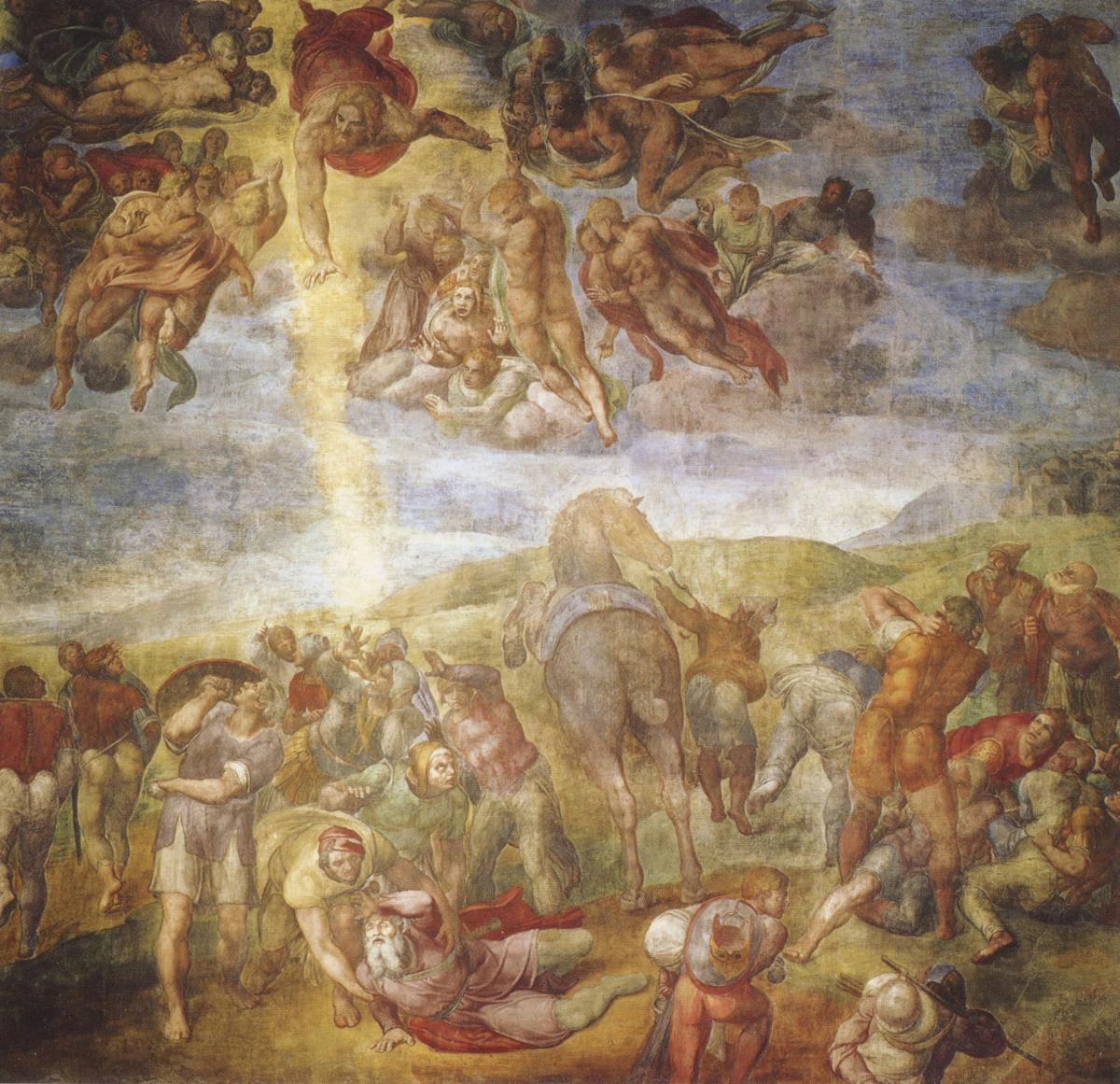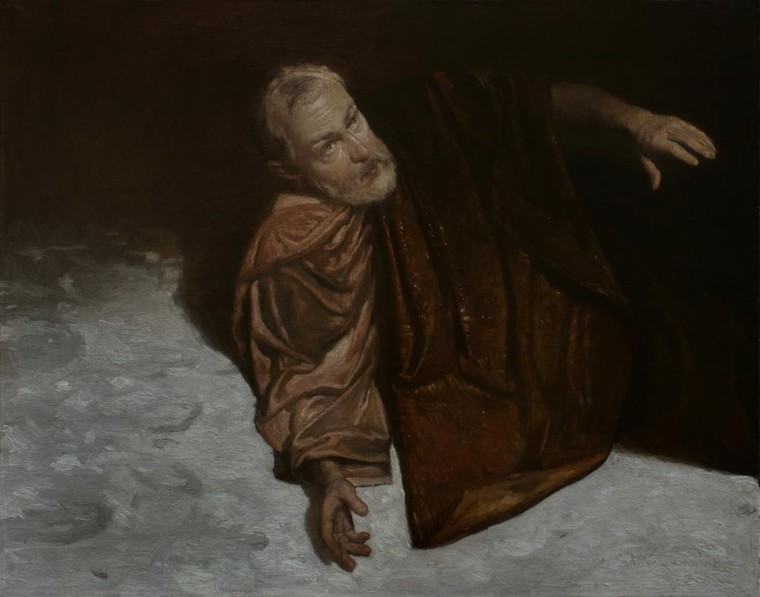February 13: The “Conversion” of Saul: The Meaning of Teshuva, Repentance and Return
♫ Music:
Saturday, February 13
Scripture: Acts 9: 1-19
But Saul, still breathing threats and murder against the disciples of the Lord, went to the high priest and asked him for letters to the synagogues at Damascus, so that if he found any belonging to the Way, men or women, he might bring them bound to Jerusalem. Now as he went on his way, he approached Damascus, and suddenly a light from heaven shone around him. And falling to the ground he heard a voice saying to him, “Saul, Saul, why are you persecuting me?” And he said, “Who are you, Lord?” And he said, “I am Jesus, whom you are persecuting. But rise and enter the city, and you will be told what you are to do.” The men who were traveling with him stood speechless, hearing the voice but seeing no one. Saul rose from the ground, and although his eyes were opened, he saw nothing. So they led him by the hand and brought him into Damascus. And for three days he was without sight, and neither ate nor drank. Now there was a disciple at Damascus named Ananias. The Lord said to him in a vision, “Ananias.” And he said, “Here I am, Lord.” And the Lord said to him, “Rise and go to the street called Straight, and at the house of Judas look for a man of Tarsus named Saul, for behold, he is praying, and he has seen in a vision a man named Ananias come in and lay his hands on him so that he might regain his sight.” But Ananias answered, “Lord, I have heard from many about this man, how much evil he has done to your saints at Jerusalem. And here he has authority from the chief priests to bind all who call on your name.” But the Lord said to him, “Go, for he is a chosen instrument of mine to carry my name before the Gentiles and kings and the children of Israel. For I will show him how much he must suffer for the sake of my name.” So Ananias departed and entered the house. And laying his hands on him he said, “Brother Saul, the Lord Jesus who appeared to you on the road by which you came has sent me so that you may regain your sight and be filled with the Holy Spirit.” And immediately something like scales fell from his eyes, and he regained his sight. Then he rose and was baptized; and taking food, he was strengthened.
THE “CONVERSION” OF SAUL: THE MEANING OF TESHUVA, REPENTANCE AND RETURN
As I think about Saul’s experience on the Damascus Road, I think about him as a devout Jew zealous for the Torah, a man willing to prosecute those followers of the Way as apostates from the community of the faithful, a man willing to execute those Jews who had accepted Jesus as their Messiah and King. I think of Saul’s heart, and how he must have constantly meditated on the meaning of Psalm 119, the ultimate expression of the Jewish devotion to Yahweh. And so I turned to Psalm 119 to think about what happened to Saul when he saw that brilliant light, and the interior conversation between Yeshu’a and this Jewish believer in that moment of epiphany.
Psalm 119 reveals itself to be a conversation between two persons about the value of the law, the perfect, eternal precepts given to us by God to rule our lives. The two persons are a righteous man and a sinner.
Psalm 119 reveals the private conversation that none of Saul’s companions could have heard or seen. Michelangelo’s scene is a freeze-frame of that moment, invisible to onlookers. They are outsiders, puzzled and concerned about what they could only imagine was some sort of sickness that had suddenly struck their leader. While they could see nothing, Saul is instantly transported into the spiritual dimension that has overtaken him with the speech-act of Christ when he called out to him. He sees Christ reaching out to him from heaven, and is blinded by a flash of insight into the true nature of the Word of God, Yeshu’a, his Kinsman-Redeemer. He realizes his sin and is convicted of his hatred. He feels with sickening recognition the sin he has committed against those followers of the Way that he has prosecuted, leading to their deaths. He realizes he is a murderer. He understands that his violence is as evil as the violence of the Zealots plaguing Israel under the Hasmoneans. He realizes, in that same flash of insight, that Yahweh has forgiven him in the person of Jesus Christ. Jesus is now calling him to a new mission in his name. Saul worships the annointed Savior of Israel and of all humanity, as he is filled with awe at God’s grace and mercy. Saul realizes that he has been granted a reprieve so that God can bless his people and all humanity with the good news of Jesus’ love.
Let us now turn to Psalm 119 in more detail, and look more deeply at the art and music that accompanies our Scripture.
Verses 1-52 of Psalm 119 is written in the voice of Jesus, the Righteous Man, who has the law in his heart and does not sin. He is pictured by Michelangelo, coming from Heaven accompanied by angels, to reproach Saul for persecuting him.
Verses 53-66 are written in the voice of Saul as he travels towards Damascus. He is the exemplar of every zealous person who self-righteously judges and condemns sinners and in so doing sins against God, the only righteous judge. Stroope’s lyrics are the soundtrack of the journey:
Saul! Murder, harass, bind into chains! Chain, prosecute and harass!
It is at this point that the account of Acts gives us a view of Saul’s encounter with the risen Christ. The Lord descends and appears to him, crying out, in the words of the song:
Why do you persecute me, Saul?
Why, why, why?
Fall down on your knees, turn hatred into love.
Turn darkness into light.
Bow down, Saul! Bow down, Saul!
Saul, Saul, Saul.
Michelangelo depicts Jesus, who diligently meditated on the Law day and night since his youth, obeying it with perfect understanding because of his reverence for God, His Father. Christ, the Righteous Judge, understands perfectly the true meaning of the teachings of the Torah. He confronts Saul, who, in striving for righteousness, transgresses the Law, ending up a murderer because he did not understand the Law he loved so much. Christ descends in a flash of light, His glory, revealing the Truth to the sinner.
Verses 67-176 reveal to us the inner workings of Saul’s response to his encounter with Jesus. Russian artist Mironov, depicts Saul as he recognizes Jesus as Lord and realizes in horror that he has misunderstood the very meaning of righteousness. He is convicted by the knowledge that he has been blinded by his zeal for punishing sinners. Saul’s love of the precepts of the law has drawn him close to God; God has drawn near in answer to his piety and devotion, finally and fully revealing the wisdom that he had so earnestly pursued. The realization of that Truth turned Saul away from his self-righteous condemnation of sinners to compassion for them. This is indeed the good news of repentance as Saul turned into Paul.
PRAYER
Father, I thank you for turning me back to you in Christ Jesus, who, in a personal moment of epiphany, made Himself known to me, turning me back in repentance (teshuva) for my sins, to worship you as I recognized you as the God of my people, our Creator, Savior, Kinsman-Redeemer and King. Lord, we confess that the term “conversion” offends many who seek you, because they do not understand the true meaning of the transformation of the heart that occurs in the moment of our salvation. We recognize that no one can coerce belief in you. You are the only saving power. We earnestly pray that you would turn all hearts back to you in humility, confessing their sins and receiving your mercy and your grace.
Amen.
Judith Mendelsohn Rood, Professor of History and Middle Eastern Studies
Artwork #1
The Conversion of Saul (Detail)
Michelangelo
Fresco
Cappella Paolina, Palazzi Pontifici, The Vatican
About the Artist and the Art #1
Michelangelo di Lodovico Buonarroti Simoni (1475-1564) was an Italian Renaissance sculptor, painter, architect, and engineer. During his lifetime he was considered the greatest living artist, and he has exerted an unparalleled influence on the development of Western Art. He is the best-documented artist of the 16th century, and his output in every field of interest was prolific. Among his works are the "David" and "Pieta" statues, and the Sistine Chapel frescoes, which were completed the year before Michelangelo painted this depiction of Saul’s conversion. The innovative use of light and shadow in the composition amplifies the sense of emotion and drama, highlighting the moment of Saul’s spiritual awakening.
Artwork #2
The Conversion of Saul
Andrey Mironov
Oil on canvas
About the Artist and the Art #2
Andrey Mironov (b. 1975) is a prolific Russian artist. His paintings and prints focus on religious themes and aim to portray his Christian ideals. His oil paintings of biblical scenes are reminiscent of Caravaggio with their dramatic lighting and detailed portraiture.
About the Music
“The Conversion of Saul”
Lyrics
Caedite, vexate, ligate vinculis!
Saul! Murder, harass, bind into chains! Saul!
Vinculis, condemnate vexate!
Chain, prosecute and harass!
Why do you persecute me, Saul?
Why, why, why?
Fall down on your knees, turn hatred into love.
Turn darkness into light.
Bow down, Saul! Bow down, Saul!
Saul, Saul, Saul.
About the Composer
Z. Randall Stroope (b. 1953) is an American composer, conductor, and lecturer. He has published more than 125 pieces of music. Among his most famous works are: “Lamentaciones de Jeremias,” “Amor de mi Alma,” and “Hodie! (This Day).” Stroope serves as a professor of conducting and as the Director of Choral and Vocal Studies at Oklahoma State University. He also heads the Oklahoma State University Concert Chorale, Chamber Choir, and Women's Choir. As a conductor, he regularly appears nationally and internationally in venues such as Carnegie Hall and the Kennedy Center. “The Conversion of Saul” is one of his more popular short choral works, and has sold over 3 million copies.
www.zrstroope.com
About the Performers
The University of Nebraska at Omaha Concert Choir is an auditioned choral ensemble that performs large master works. The choir is made up of students from all majors. The UNO Concert Choir has traveled to several European nations including the countries of Lithuania, Sweden, Germany, the Czech Republic, Romania, Moldova, Russia, Finland, and the Baltics. They have also performed at venues throughout the USA including New York’s Carnegie Hall.

